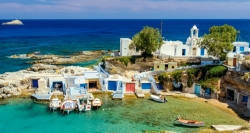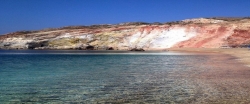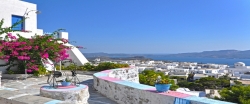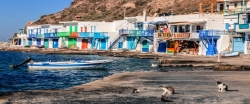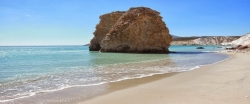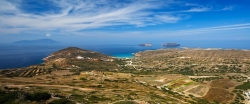Le nostre destinazioni più richieste
I nostri tour:
Common description
The island of Venus
The island of Mílos, in the Cyclades archipelago, is an intact, multicolored and varied world. The statue of Venus was found here in 1820 and is now kept in the Louve museum in Paris. There are numerous beaches with crystal clear blue waters, sculpted and colored rocks, olive trees and white villages, walls overlooking the Aegean. The Greek identity and way of life resonate very strongly here.
Mílos is considered by many to be a true paradise. Not only for its splendid beaches and views, but also for the variety of sports that can be practiced, such as diving, windsurfing and kayaking around the island. And again, use the bicycle on remote paths away from traffic, go on excursions by car to discover the most hidden and interesting villages rich in history, architecture and traditions. The picturesque villages, in fact, are excellent examples of the typical architecture of the island.
Some beaches recommended by Karlitalia
Only in recent years have its wonderful beaches been rediscovered, with the colors of the coasts and the sea which have given it the name "island of colours". Milos offers over 75 beaches of volcanic nature, with crystal clear blue waters, sculpted and colorful rocks. There are platinum-colored sand beaches, sometimes pebble bays closed by white, red, yellow or black rocks. You can swim in well-equipped beaches or choose a more secluded and wild one.
To the north there are the best-known beaches, such as Firopotamos, with a bay and some fishermen's houses. In Mandrakia, a small bay with a pier, an incredibly characteristic place with fishermen's houses. In Sarakiniko, the landscape is almost lunar, with white rocks. Ag. Konstantinos is a small fishing settlement, with a lagoon between the rocks and garages for boats on the sea. In Papafragas the sea is wedged between two ridges creating plays of light. In Pollonia the beach with tamarisk trees is gulf-shaped.
In the south the beaches are quieter. In Paliochori (10 km from Adamas), the beach is wide with pebbles and has many restaurants, and is perhaps the most beautiful. The waters of Aghia Kiriaki are cool, with colorful pebbles and a wide stretch of coarse sand. In Tzigrado, the small beach below is a 25-metre slope of white sand (perlite), with unique colours. Firiplaka is a beach next to Tsigrado surrounded by multicolored rocks. Provatas, on the other hand, is a beach of fine golden sand. Gerontas is a beautiful bay embraced by majestic cliffs and caves; here the sand is dark and the waters are turquoise. The bridge-shaped rock that connects the sea to the land and the clarity of the water will amaze you.
Things to do and see in Milos: our suggestions
Milos is known as the Island of Venus due to the discovery in the last century of the statue of Aphrodite (Venus), now in the Louvre museum in Paris.
• In Plaka, the capital of Milos, the archaeological museum is unmissable, where various artefacts from the excavations are on display. There is also a copy of the Venus de Milo on the island.
• At the Folklore Museum you will discover the habits and customs of the population. The church dedicated to the Virgin Mary has many interesting icons and is a strategic place to admire a wonderful panorama.
• Starting from Adamas - one of the largest natural ports in the Mediterranean - with the boat, you will be able to admire the surprising colors of the sea: sometimes blue, green, even red and purple, in contrast with the walls of the white, pink, green coasts and also yellow.
• You can thus discover the beaches that can be reached by sea such as Kleftiko, Gherakas and Sikia. In the village of Klima you can visit the ancient catacombs. There are many archaeological sites, such as the ancient Roman theater and the ancient city of Filakopi. The mines are also places of particular interest.
• In the summer months you can take part in the cultural festival which gives you the opportunity to get to know the locals, appreciate their traditions and try the tasty local dishes. To visit the churches and chapels of the island, the ecclesiastical museum and the catacombs. Milos has recently been declared a holy island by the Greek Orthodox Church.
Where it is and how to reach Milos
Where it is: Milos is the fifth largest island of the Cyclades and is located on the southwestern tip of the archipelago. It is located 86 miles (138.40 km) from Piraeus in the middle of the Piraeus-Crete route.
How big: Milos has an area of 151 sq km. with a population of 4,966 inhabitants divided into seven hamlets. The island is shaped like a horseshoe, with a large gulf overlooked by the sunny hills. There are 75 large and small beaches, some reachable only by sea. The clear waters of the island and the infinite beauty of the beaches will offer you an unprecedented experience. The road network is excellent.
By plane:
You can reach Milos from Athens by plane; during the summer season there are at least two flights a day from Eleftherios Venizelos airport in Athens directly to Milos. The journey is only 30 minutes and is usually carried out by planes with 37 seats. Milos airport is approximately 4 km from Adamas, one of the largest natural harbors in the Mediterranean (5 minutes by car). There are buses to and from the airport. From the port, the road leads to Plaka (the capital) and Kastro, above it.
On boat:
You can reach Santorini by plane and then take the ferry to reach Milos in just two hours, with afternoon schedules. From Piraeus, the main port of Greece, there are daily connections with ferries and fast ships (some pass through other ports on nearby islands and some are direct), with the possibility of also taking your car on board. The main port of Adamas and another port in Apollonia connect the island of Milos with the islands of Kimolos and Glaronissia.
More information, useful advice and curiosities in the travel documents that will be sent before departure.
The island of Mílos, in the Cyclades archipelago, is an intact, multicolored and varied world. The statue of Venus was found here in 1820 and is now kept in the Louve museum in Paris. There are numerous beaches with crystal clear blue waters, sculpted and colored rocks, olive trees and white villages, walls overlooking the Aegean. The Greek identity and way of life resonate very strongly here.
Mílos is considered by many to be a true paradise. Not only for its splendid beaches and views, but also for the variety of sports that can be practiced, such as diving, windsurfing and kayaking around the island. And again, use the bicycle on remote paths away from traffic, go on excursions by car to discover the most hidden and interesting villages rich in history, architecture and traditions. The picturesque villages, in fact, are excellent examples of the typical architecture of the island.
Some beaches recommended by Karlitalia
Only in recent years have its wonderful beaches been rediscovered, with the colors of the coasts and the sea which have given it the name "island of colours". Milos offers over 75 beaches of volcanic nature, with crystal clear blue waters, sculpted and colorful rocks. There are platinum-colored sand beaches, sometimes pebble bays closed by white, red, yellow or black rocks. You can swim in well-equipped beaches or choose a more secluded and wild one.
To the north there are the best-known beaches, such as Firopotamos, with a bay and some fishermen's houses. In Mandrakia, a small bay with a pier, an incredibly characteristic place with fishermen's houses. In Sarakiniko, the landscape is almost lunar, with white rocks. Ag. Konstantinos is a small fishing settlement, with a lagoon between the rocks and garages for boats on the sea. In Papafragas the sea is wedged between two ridges creating plays of light. In Pollonia the beach with tamarisk trees is gulf-shaped.
In the south the beaches are quieter. In Paliochori (10 km from Adamas), the beach is wide with pebbles and has many restaurants, and is perhaps the most beautiful. The waters of Aghia Kiriaki are cool, with colorful pebbles and a wide stretch of coarse sand. In Tzigrado, the small beach below is a 25-metre slope of white sand (perlite), with unique colours. Firiplaka is a beach next to Tsigrado surrounded by multicolored rocks. Provatas, on the other hand, is a beach of fine golden sand. Gerontas is a beautiful bay embraced by majestic cliffs and caves; here the sand is dark and the waters are turquoise. The bridge-shaped rock that connects the sea to the land and the clarity of the water will amaze you.
Things to do and see in Milos: our suggestions
Milos is known as the Island of Venus due to the discovery in the last century of the statue of Aphrodite (Venus), now in the Louvre museum in Paris.
• In Plaka, the capital of Milos, the archaeological museum is unmissable, where various artefacts from the excavations are on display. There is also a copy of the Venus de Milo on the island.
• At the Folklore Museum you will discover the habits and customs of the population. The church dedicated to the Virgin Mary has many interesting icons and is a strategic place to admire a wonderful panorama.
• Starting from Adamas - one of the largest natural ports in the Mediterranean - with the boat, you will be able to admire the surprising colors of the sea: sometimes blue, green, even red and purple, in contrast with the walls of the white, pink, green coasts and also yellow.
• You can thus discover the beaches that can be reached by sea such as Kleftiko, Gherakas and Sikia. In the village of Klima you can visit the ancient catacombs. There are many archaeological sites, such as the ancient Roman theater and the ancient city of Filakopi. The mines are also places of particular interest.
• In the summer months you can take part in the cultural festival which gives you the opportunity to get to know the locals, appreciate their traditions and try the tasty local dishes. To visit the churches and chapels of the island, the ecclesiastical museum and the catacombs. Milos has recently been declared a holy island by the Greek Orthodox Church.
Where it is and how to reach Milos
Where it is: Milos is the fifth largest island of the Cyclades and is located on the southwestern tip of the archipelago. It is located 86 miles (138.40 km) from Piraeus in the middle of the Piraeus-Crete route.
How big: Milos has an area of 151 sq km. with a population of 4,966 inhabitants divided into seven hamlets. The island is shaped like a horseshoe, with a large gulf overlooked by the sunny hills. There are 75 large and small beaches, some reachable only by sea. The clear waters of the island and the infinite beauty of the beaches will offer you an unprecedented experience. The road network is excellent.
By plane:
You can reach Milos from Athens by plane; during the summer season there are at least two flights a day from Eleftherios Venizelos airport in Athens directly to Milos. The journey is only 30 minutes and is usually carried out by planes with 37 seats. Milos airport is approximately 4 km from Adamas, one of the largest natural harbors in the Mediterranean (5 minutes by car). There are buses to and from the airport. From the port, the road leads to Plaka (the capital) and Kastro, above it.
On boat:
You can reach Santorini by plane and then take the ferry to reach Milos in just two hours, with afternoon schedules. From Piraeus, the main port of Greece, there are daily connections with ferries and fast ships (some pass through other ports on nearby islands and some are direct), with the possibility of also taking your car on board. The main port of Adamas and another port in Apollonia connect the island of Milos with the islands of Kimolos and Glaronissia.
More information, useful advice and curiosities in the travel documents that will be sent before departure.

